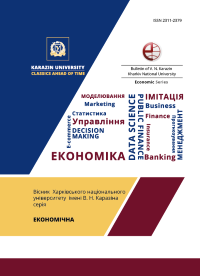Finance and technology. Trends that determine the development and transformation of banking business
Abstract
The article is dedicated to analyzing contemporary changes in the banking business that have occurred since the forced isolation caused by the COVID-19 pandemic. The pandemic rapidly triggered the most extensive transformation in banking technology, client-bank communication, and the emergence of new opportunities driven by digital financial services. The drivers of new services (embedded finance, Buy Now Pay Later (BNPL)) are the Millennials and Generation Z. Cybersecurity risks and digital financial fraud have significantly increased. There is a need for competence growth of skills among both bank employees and clients. A fundamental question has arisen regarding the balance between the use of digital technologies and human involvement in the banking business, leading to a broad expert and academic dialogue (the Phygital challenge). The pandemic also impacted the macroeconomic situation in the global economy. The need for support for the population and small to medium-sized businesses led governments to resort to issuance. The consequences were economic imbalances and inflation growth in leading economies. However, measures to counter inflation and stabilize the economy resulted in an increase in interest rates in the U.S. and the EU, as the world's leading economies. This allows a return to traditional banking practices and a reassessment of interactions with FinTech solutions. The major changes analysis helps to identify the most significant trends influencing modern banking, thereby allowing the forecasting of the development dynamics of the situation.
Downloads
References
Accenture Banking. (2023). Top 10 Trends for 2023. Retrieved from https://www.accenture.com/us-en/insights/banking/top-10-trends-banking-2023
McKinsey & Company. (2023). The great banking transition. Retrieved from https://www.mckinsey.com/industries/financial-services/our-insights/global-banking-annual-review
Cambridge Centre for Alternative Finance. (2020). A Global AI in Financial Services Surve. Retrieved from https://www.jbs.cam.ac.uk/faculty-research/centres/alternative-finance/
Sopra Steria. (2022). Digital banking experience report. Retrieved from https://www.soprasteria.com/
VISA Consulting & Analytics. (2022). 10 trends set to shape the 2023 payments landscape. Retrieved from https://navigate.visa.com/na/spending-insights/10-trends-set-to-shape-the-2023-payments-landscape/
Capgemini Invent. (2022). From digital to next-generation banking. Retrieved from https://www.capgemini.com/solutions/next-gen-financial-services/
McKinsey & Company. (2022). Embedded finance: Who will lead the next payments revolution? Retrieved from https://www.mckinsey.com/industries/financial-services/our-insights/embedded-finance-who-will-lead-the-next-payments-revolution
IBM Institute for Business. (2023). Embedded finance. Creating the everywhere, everyday bank. Retrieved from https://www.ibm.com/thought-leadership/institute-business-value/en-us/report/embedded-financev
AltFi. (2023). Research Embedded Finance: The New Frontier of Lending. Retrieved from https://www.altfi.com/research/embedded-finance-the-new-frontier-of-lending
Deloitte. (2022). The Global Gen Z & Millenial Syrvey. Striving for balance, advocating for change. Retrieved from https://www2.deloitte.com/content/dam/insights/articles/glob175227_global-millennial-and-gen-z-survey/Gen%20Z%20and%20Millennial%20Survey%202022_Final.pdf
Coin Market Cap. (2023). Retrieved from www.coinmarketcap.com
Aleksandrov, A. (2022). Digital State & Business: Practical Implementation of NFT Techologies. The XI International Research-to-Practice Conference «SocietyTransformations in Social and Human Sciences». Riga: Baltic International Academy, 29-34.
McKinsey & Company. (2023). What is central bank digital currency (CBDC)? Retrieved from https://www.mckinsey.com/featured-insights/mckinsey-explainers/what-is-central-bank-digital-currency-cbdc
FBI IC3. (2021). Internet Crime Report. Retrieved from https://www.ic3.gov/Media/PDF/AnnualReport/2021_IC3Report.pdf
Cybercrime Magazine. (2023). Top 10 Cybersecurity Predictions and Statistics for 2023. Retrieved from https://cybersecurityventures.com/stats/
Capgemini Research Institute. (2023). Wealth Management Trends Book 2023 Retrieved from https://prod.ucwe.capgemini.com/be-en/wp-content/uploads/sites/14/2022/12/Wealth-Management-Trends-Book-2023.pdf
Aleksandrov, A. (2021). Phygital: measure of the human factor in digital technologies. Where is the right balance? Huxley. Retrieved from https://huxley.media/phygital-mera-chelovecheskogo-v-cifrovyh-tehnologijah-gde-vernyj-balans/ (in Russian)
Capgemini. (2022). From digital to next generation banking. Retrieved from https://www.capgemini.com/

